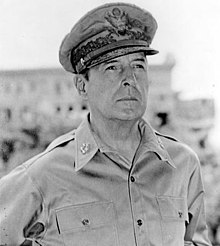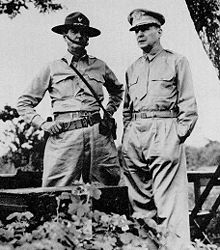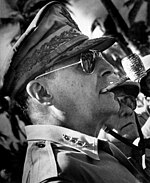Douglas MacArthur
Douglas MacArthur (born January 26, 1880 in Little Rock , Arkansas , † April 5, 1964 in Washington, DC ) was a career officer in the US Army . He was brigadier general in World War I and was General of the Army in World War II had, together with Admiral Chester W. Nimitz the supreme command over the Pacific theater and after the war, the supreme command of the occupation forces in Japan held.
During the Korean War he commanded the UN troops until his release on April 11, 1951. He is one of the most decorated soldiers in the history of the US armed forces .
biography
family
MacArthur came from a family of officers who were also politically active. His grandfather Arthur MacArthur senior (1815-1896) was governor of Wisconsin . His father Arthur MacArthur Jr. (1845–1912) was a lieutenant general in the US Army. His son is Arthur MacArthur (* 1938).
In 1922 he married Louise Cromwell Brooks, from whom he divorced in 1929. In 1937 he married Jean Marie Faircloth.
training
MacArthur completed his training at the Military Academy in West Point in 1903 as the best of his year and then went to the Philippines as Second Lieutenant of the US Army Corps of Engineers until 1904 . It was in 1904 the First Lieutenant ( Lieutenant ), 1911 Captain ( captain ) 1915 Major and 1917 Colonel ( Colonel ).
First World War
During the First World War , MacArthur served in France with the 42nd US Division, where he was promoted to the youngest Brigadier General in the US Army in June 1918 . He took part in the Battle of the Marne and led the 84th US Infantry Brigade in the Battle of St. Mihiel and the Meuse-Argonne Offensive .
Between the wars
After the war, MacArthur was stationed in Sinzig as commander of the 84th Infantry Brigade as part of the Allied occupation of the Rhineland . On his return to the United States, he was superintendent of the West Point Military Academy for three years . During this time, he fundamentally reformed officer training. He then commanded units in the Philippines and was responsible for the Manila district . In 1925 he was promoted to major general .
From 1930 to 1935 he was a (temporary) four-star General Chief of Staff of the Army .
In July 1932 MacArthur was tasked by President Herbert Hoover with the crackdown on the so-called Bonus Army , a protest movement by World War II veterans who demonstrated in Washington around Capitol Hill for the payment of their bonuses, which had previously been rejected by the Senate . His tough crackdown on the demonstrators, going beyond the President's instructions, using tanks and cavalry and infantry with bayonets attached, resulted in a hundred injuries and the death of a child. In addition, the Hooverville of the protesters on the Anacostia River burned down during the violent midnight eviction.
Philippines and the beginning of World War II
In 1935, the Commonwealth of the Philippines was established under US domination and the first elected President Manuel Luis Quezon y Molina convinced General MacArthur to build an independent Philippine Defense Army. MacArthur became a military adviser in the Philippines, where he undertook this task with the assistance of Major Eisenhower and Major Ord .
As the Japanese threat increased, the United States decided in early 1941 to arm the Philippines. To this end, the United States Army Forces, Far East (USAFFE) were set up on July 26, 1941 . MacArthur was Lieutenant General from July 27th . In August 1941, it was clear that these forces could not withstand a possible Japanese invasion due to the lack of weapons such as anti-aircraft guns , tanks and modern combat aircraft . The USA promised to provide adequate armament by early 1942. The offered transfer of a unit of the National GuardMacArthur refused. He was optimistic and, given the growing shipments of aircraft and other supporting materials, he assumed he could develop the Philippines into a self-defending fortress. Defense against a Japanese attack should then not be a problem. He also believed that he could control the entire China Sea with American aircraft.
After the attack on Pearl Harbor on December 7, 1941 , MacArthur , who was promoted to general , and his command staff quickly discovered that they had little to counter the superiority of the Japanese armed forces . Together with Brigadier General Jonathan Wainwright , MacArthur worked out a withdrawal plan that stipulated that all Allied troops in Luzon should withdraw to the Bataan Peninsula by early January 1942 .
This plan was successfully carried out, but when the situation became hopeless, the US Department of War withdrew MacArthur from the Philippines in March to appoint him commander in chief of allied forces in the Southwest Pacific Area . He was replaced by a direct order from Roosevelt by Jonathan Wainwright, who was captured by Japan in May 1942. MacArthur was awarded the Medal of Honor after his safe arrival in Australia , but not without first giving his promise: "I'll be back".
Southwest Pacific
In this position, conferred on him on April 18, 1942, MacArthur and his task force in his headquarters ( GHQ ) in Australia worked out several revised plans that provided for an advance of the Allied troops over the north coast of New Guinea towards the Philippines. These so-called RENO plans primarily envisaged conquering Japanese airfields and the final goal was to cut through the Japanese supply routes from Southeast Asia . Then the jump to the southern Philippines should take place (→ Battle of Leyte ). The campaign for the liberation of New Guinea began in autumn 1942 and in October 1944 also theRecapture of the Philippines .
On December 18, 1944, MacArthur was promoted to General of the Army .
Surrender of Japan and the post-war period

On September 2, 1945, he took the Japanese surrender on the USS Missouri counter and served as Supreme Commander of the Allied Powers (Engl. Supreme Commander for the Allied Powers , in short: SCAP) subsequent demilitarization and democratization of the country. Under his responsibility, allied military tribunals carried out trials against Japanese war criminals as early as 1945, before the Tokyo trials of the main war criminals opened in 1946 . His staff worked out the first drafts of the Japanese constitution, which came into force in 1947 . On April 11, 1951, President Truman replaced MacArthur with GeneralMatthew Ridgway .
MacArthur had a significant influence on the postwar order of Japan. However, the fact that some of those co-responsible for war crimes, most notably Emperor Hirohito and other members of the imperial family, were not charged also sparked controversy.
In 1948 MacArthur ran for the Republicans in the presidential election , but withdrew his candidacy because he could not win a majority in the primary elections in the state of Wisconsin .
Korean War
After the invasion of South Korea by North Korean troops on June 25, 1950, MacArthur was given supreme command of the UN - mandated international troops, which he led to their first success in the Incheon landing . In the course of the war and in view of the deployment of Chinese volunteers and soldiers, he vehemently advocated the use of nuclear weapons in 49 North Korean cities and the expansion of the conflict to the People's Republic of China . US President Harry S. Truman these specific claims rejected several times and eventually called MacArthur because of his continued and partially public insistence on 11 April 1951 from his post from . This decision sparked violent protests in Congress and public demonstrations for MacArthur. Seven million people reportedly took part in a parade in New York. Public opinion saw MacArthur as a great war hero, while President Truman was largely unpopular. For a few weeks it seemed possible that MacArthur could take over government. Public attitudes tipped, however, when the Chairman of the Joint Chiefs of Staff , General Omar N. Bradley, in a testimony to the Senate, pointed to the devastating effects of MacArthur's demands on the US strategic position in Western Europe. The historian Niall Ferguson compared the Truman-MacArthur power struggle with Roman history:
“1951 was arguably the only moment in history when America was on the verge of sharing the fate of the Roman Republic . The man who would have played the role of Caesar was General Douglas MacArthur. [...] In a sense, he crossed the Rubicon when he publicly criticized Truman. The president's challenge received not only the applause, but the support of the Republican leadership in Congress as well as a sizeable section of the conservative press. When Truman had him relieved and he was received at home as a hero, the constitution seemed to be up for grabs. "
Late years
MacArthur returned to the United States, where he was celebrated as a hero. After another attempt at the presidency, he gave up his political ambitions in 1952 and lived from then on in New York . He published a lot and received numerous honors.
In later years, under the influence of Article 9 of the new Japanese constitution , MacArthur campaigned vehemently for a worldwide abolition of the military in speeches to Congress , the Senate and also in public. This article states that the Japanese military should be equipped for the sole purpose of self-defense.
Douglas MacArthur died in Washington, DC in 1964 at the Walter Reed Military Hospital . An estimated 150,000 people followed the funeral procession in Washington. He was buried at his request in Norfolk , Virginia.
honors and awards
- MacArthur Memorial with memorial and sarcophagus in Norfolk. He also found his final resting place at the MacArthur Memorial.
- MacArthur Foundation, which awards awards and scholarships to young officers annually.
- MacArthur Leadership Award presented by the Royal Military College of Canada in Kingston , Ontario
- Douglas-MacArthur Tunnel on Highway 1 , which passes under the former Presidio military site and now part of the Golden Gate National Recreation Area in San Francisco .
- Los Angeles' Westlake Park, dating from 1880, was renamed MacArthur Park in 1942 .
- Various streets got his name.
- He is ranked 17th in the historical ranking of the highest officers in the United States .
- His hundreds of US and international awards include a. a .: The Medal of Honor , the Distinguished Service Cross with two oak leaves, the Distinguished Service Medal of the US Army with four oak leaves, the Navy Distinguished Service Medal , the Silver Star with seven oak leaves, the Distinguished Flying Cross , the Bronze Star with V -Award (V for Valor; Am.-Engl. For bravery), the Purple Heart with oak leaves, and the Presidential Unit Citation with six oak leaves.
reception
Movie:
- Generals Of WWII - George Marshall / Douglas MacArthur
- The Collectors Biography Series - Douglas MacArthur , 1995
- MacArthur-Hero of the Pacific , 1977
- Emperor - Fight for Peace , 2012
- The World Wars , 2014
- Operation Chromite , 2016
Others:
- The cover picture of Perry Rhodan's booklet No. 492, The Steel Prison (1971), created by Johnny Bruck , depicts the fictional character Reginald Bull . She bears the features of Douglas MacArthur.
literature
- Douglas MacArthur: Reminiscences . 1964 and 2001 2nd edition, Bluejacket Books, ISBN 978-1-55750-483-8 .
- Ann Graham Gaines: Douglas MacArthur: Brilliant General, Controversial Leader (Historical American Biographies) . Enslow Publishers, 2001, ISBN 0-7660-1445-2 .
- William Manchester: American Caesar: Douglas MacArthur 1880–1964 . Dell Publishing Company, 1996, ISBN 0-440-30424-5 .
- Stephanie Sammartino McPherson, Tim Parlin: Douglas MacArthur (History Maker Bios) . Lerner Pub Group, 2004, ISBN 0-8225-2434-1 .
- Earle Jr. Rice: Douglas MacArthur (Gml) (Great Military Leaders of the Twentieth Century) . Chelsea House Publications, 2004, ISBN 0-7910-7402-1 .
- Winfried Scharlau: The General and the Kaiser. The American occupation of Japan 1945–1952 . Hauschild, Bremen 2003, ISBN 3-89757-197-8 .
Web links
- Douglas MacArthur in the nndb (English)
- Literature by and about Douglas MacArthur in the catalog of the German National Library
- Newspaper article about Douglas MacArthur in the 20th century press kit of the ZBW - Leibniz Information Center for Economics .
- Extensive biography (English)
- ( Page no longer available , search in web archives: biography page of the US Navy )
- Tabular CV of the US Army (English)
- MacArthurMemorial Homepage (English)
Individual evidence
- ↑ Obituary of the United States Department of Defense of April 6, 1964 ( Memento of the original of November 3, 2013 in the Internet Archive ) Info: The archive link was inserted automatically and has not yet been checked. Please check the original and archive link according to the instructions and then remove this notice. . On: armypubs.army.mil (PDF).
- ↑ Dr. Richard Volk: “MacArthur in“ dear old Sinzig ”; The Schönberg House as the headquarters of the US General 1918/19 ”, pp. 192–198 in the home book of the Ahrweiler district 2018
- ^ Richard B. Frank: MacArthur . Great Generals. Palgrave Macmillan, New York City 2007, ISBN 978-0-230-61076-7 , pp. 23–24 ( books.google.de ).
- ^ William E. Leuchtenburg: Herbert Hoover . The American Presidents Series: The 31st President, 1929-1933. In: Arthur M. Schlesinger, Jr., Sean Wilentz (Eds.): The American Presidents . tape 31 . Macmillan, New York City 2009, ISBN 978-1-4299-3349-0 , pp. 135-136 ( books.google.de ).
- ^ David M. Kennedy : Freedom from Fear - The American People in Depression and War. Oxford, 1999, p. 530.
- ↑ Niall Ferguson: The Denied Empire. Opportunities and Risks of American Power. Propylaen Verlag, Berlin 2004, ISBN 3-549-07213-9 , p. 115.
- ^ The Republican candidate, however, was Dwight D. Eisenhower in 1952 ; he won the election in November 1952
- ↑ Narihiko Ito: The Peace Article of the Japanese Constitution. For a world without war and the military. Agenda Verlag, Münster 2006, p. 70 ff.
- ↑ knerger.de: The grave of Douglas MacArthur
- ^ MacArthur Foundation
- ↑ MacArthur Park on the Los Angeles Conservancy website
- ^ Cover picture by Johnny Bruck on William Voltz : The Steel Prison, Perry Rhodan No. 492, Moewig, Munich, 1971.
| personal data | |
|---|---|
| SURNAME | MacArthur, Douglas |
| BRIEF DESCRIPTION | American general |
| DATE OF BIRTH | January 26, 1880 |
| PLACE OF BIRTH | Little Rock , Arkansas , USA |
| DATE OF DEATH | April 5, 1964 |
| Place of death | Washington, DC , USA |




